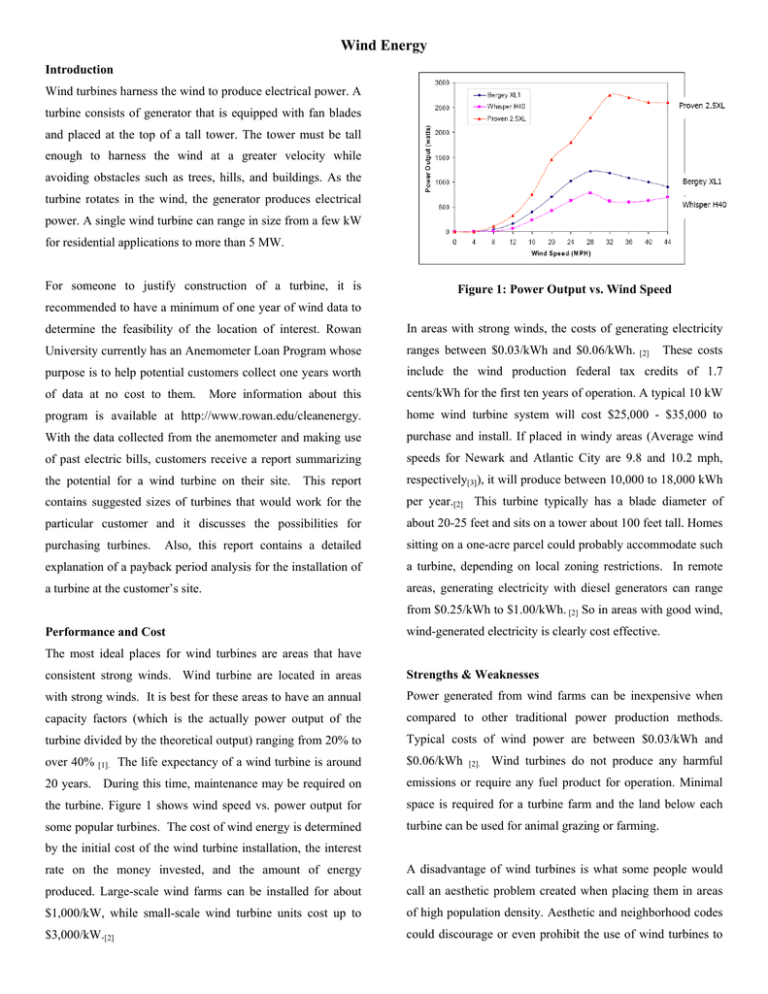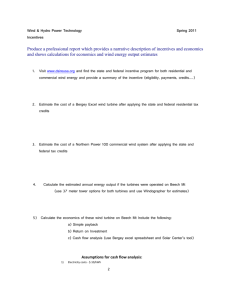Wind turbines use the wind to produce electrical
advertisement

Wind Energy Introduction Wind turbines harness the wind to produce electrical power. A turbine consists of generator that is equipped with fan blades and placed at the top of a tall tower. The tower must be tall enough to harness the wind at a greater velocity while avoiding obstacles such as trees, hills, and buildings. As the turbine rotates in the wind, the generator produces electrical power. A single wind turbine can range in size from a few kW for residential applications to more than 5 MW. For someone to justify construction of a turbine, it is Figure 1: Power Output vs. Wind Speed recommended to have a minimum of one year of wind data to determine the feasibility of the location of interest. Rowan In areas with strong winds, the costs of generating electricity University currently has an Anemometer Loan Program whose ranges between $0.03/kWh and $0.06/kWh. purpose is to help potential customers collect one years worth include the wind production federal tax credits of 1.7 of data at no cost to them. More information about this cents/kWh for the first ten years of operation. A typical 10 kW program is available at http://www.rowan.edu/cleanenergy. home wind turbine system will cost $25,000 - $35,000 to With the data collected from the anemometer and making use purchase and install. If placed in windy areas (Average wind of past electric bills, customers receive a report summarizing speeds for Newark and Atlantic City are 9.8 and 10.2 mph, the potential for a wind turbine on their site. This report respectively[3]), it will produce between 10,000 to 18,000 kWh contains suggested sizes of turbines that would work for the per year.[2] This turbine typically has a blade diameter of particular customer and it discusses the possibilities for about 20-25 feet and sits on a tower about 100 feet tall. Homes purchasing turbines. Also, this report contains a detailed sitting on a one-acre parcel could probably accommodate such explanation of a payback period analysis for the installation of a turbine, depending on local zoning restrictions. In remote a turbine at the customer’s site. areas, generating electricity with diesel generators can range [2] These costs from $0.25/kWh to $1.00/kWh. [2] So in areas with good wind, Performance and Cost wind-generated electricity is clearly cost effective. The most ideal places for wind turbines are areas that have consistent strong winds. Wind turbine are located in areas Strengths & Weaknesses with strong winds. It is best for these areas to have an annual Power generated from wind farms can be inexpensive when capacity factors (which is the actually power output of the compared to other traditional power production methods. turbine divided by the theoretical output) ranging from 20% to Typical costs of wind power are between $0.03/kWh and over 40% [1]. The life expectancy of a wind turbine is around $0.06/kWh [2]. Wind turbines do not produce any harmful 20 years. During this time, maintenance may be required on emissions or require any fuel product for operation. Minimal the turbine. Figure 1 shows wind speed vs. power output for space is required for a turbine farm and the land below each some popular turbines. The cost of wind energy is determined turbine can be used for animal grazing or farming. by the initial cost of the wind turbine installation, the interest rate on the money invested, and the amount of energy A disadvantage of wind turbines is what some people would produced. Large-scale wind farms can be installed for about call an aesthetic problem created when placing them in areas $1,000/kW, while small-scale wind turbine units cost up to of high population density. Aesthetic and neighborhood codes $3,000/kW.[2] could discourage or even prohibit the use of wind turbines to supply energy to individual homes. A map of New Jersey Residential $0.10/kWh x 10,000 kWh = $1,000 zoning regulations is shown in Figure 2 below. Commercial $0.10/kWh x 100,000 kWh = $10,000 So the residential payback period would be: $6,000/$1,000 = 6 years And the commercial payback period would be: $70,000/$10,000 = 7 years References Figures and Tables Figure 1: Wind Speed vs. Power Output of 3 Turbines From Arquin, M. (2006) http://www.kidwind.org/pdfiles/Wind%20P ower%20Curvesv3.pdf Figure 2: Zoning Regulations Figure 2: Zoning Regulations Obtained from From Rowan Clean Energy Team (2006) Municipalities End Notes Growth [1] California Energy Comission (2006) To date, the total U.S. wind energy capacity (installed) is http://www.energy.ca.gov/distgen/equipmen 10,492 MW.[5] In New Jersey, the Jersey-Atlantic Wind Farm t/wind/wind.html in Atlantic City has a rated power of 7.5 MW which could [2] U.S. DOE Office of Renewable Resources and produce enough energy to power more than 2,500 homes Alternate Energy (2006) every year! http://www1.eere.energy.gov/windandhydro /wind_technologies.html Case Study [3] NCDC Average Wind Speeds (2006) In order to fully grasp the advantage of using wind power, http://www.ncdc.noaa.gov/oa/climate/online let’s look at a hypothetical situation. Consider the total initial /ccd/avgwind.html cost of a 5 kW residential system and a 50 kW commercial system: [4] American Wind Energy Association U.S. Projects (2006) http://www.awea.org/projects/ Residential 5 kW system = $15,000 - $6,000 after rebates Commercial 50 kW system = $100,000 - $70,000 after rebates Additional Information Information on Several Wind Turbines Let’s assume the cost of electricity to be 10 cents per kWh and the annual output from the residential and commercial systems http://www.kidwind.org/pdfiles/XL1.Spec.pdf class) at a 14 mph site to be 10,000 kWh and 100,000 kWh, http://www.kidwind.org/pdfiles/Excel.Spec.Frt.pdf respectively. The annual energy-cost savings from both class) http://www.kidwind.org/pdfiles/proven.pdf systems would be: (1 kW (0.6 to 15 kW class) (10 kW




